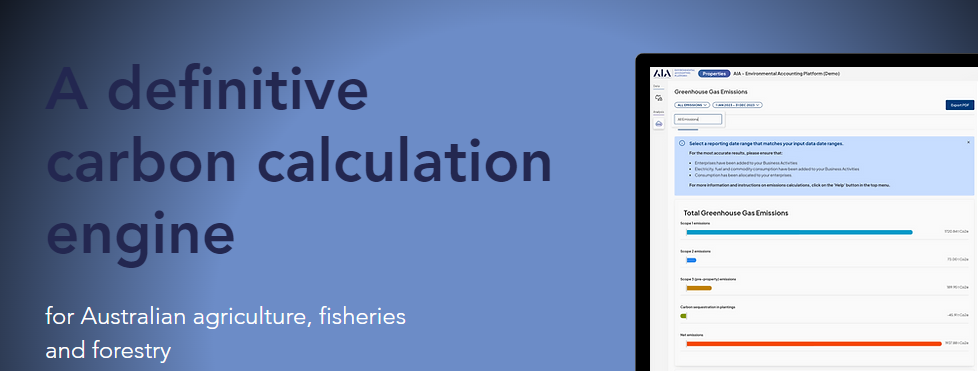Definitive cross-sectoral carbon accounting engine available now
27-May-2024Australia’s first cross-sectoral carbon accounting engine is now live, giving the agriculture, fisheries and forestry sectors a standardised approach to carbon accounting across a wide range of commodities.

The Agricultural Innovation Australia (AIA) Environmental Accounting Platform (EAP) was launched this week following an extensive period of collaboration, design, testing and refinement, including an in-depth analysis of carbon calculation tools, models and frameworks used in Australia and around the world.
The AIA EAP is a pre-competitive solution, which provides Australian producers and their supply chains with an accessible and standardised approach to carbon accounting across multiple commodities on a national scale.
It enables primary producers to calculate their carbon footprint at a commodity, enterprise and whole of business level and can also be integrated into the current service offerings of farm and business solution providers, supply chain, agribusiness, financial institutions and others.
At launch, the AIA EAP is available for beef, sheep, goat, feedlot, pork, grain, sugar, cotton and poultry commodities and will be shortly followed by dairy, rice, wine, fisheries, aquaculture and other commodities in the coming weeks.
AIA CEO, Sam Brown said the engine was setting the gold standard, avoiding the pitfalls other countries have faced with a lack of a standardised approach.
“We are excited to launch Australia’s first pre-competitive carbon calculation engine which has been born from extensive cross-sectoral collaboration,” Mr Brown said.
“Through the AIA EAP, we have simplified the complex, time consuming and confusing process of calculating carbon emissions.
“Producers are now able to enter data once to achieve a whole of enterprise carbon footprint across multiple commodities.
“We are arming individual producers and the broader agricultural industry with the data they need to drive positive environmental and economic outcomes while demonstrating to decision makers that cross-industry led solutions are achievable and valuable.”
To ensure the AIA EAP remains on the cutting edge of science and research and stays up to date with emerging standards, AIA established a Technical Advisory Panel made up of leading Australian experts in GHG accounting, emissions reductions, soil carbon management and climate science.
Chair of the AIA EAP Technical Advisory Panel and Research Program 3 Lead at the Zero Net Emissions Agriculture CRC, Professor Richard Eckard, said the AIA EAP is an important tool in helping Australia’s rural industries contribute to achieving emission reduction targets.
“Australia has committed to reducing greenhouse gas emissions by 43% come 2030 and achieving net zero by 2050. Producers can prepare by using the AIA EAP to know their emissions numbers and scenario plan to assist in understanding how they can lower that number in the future,” Professor Eckard said.
A separate AIA EAP Industry Advisory Panel is currently being formed which will ensure the platform is relevant to specific sectors by advising on emerging export and reporting requirements, adoption, and engagement.
As Sam Brown explains, Australia’s food and fibre production sectors have a crucial role to play in reducing greenhouse gas emissions.
“There is increasing pressure for primary producers to be able to calculate and measure their on-farm carbon emissions to access international markets and even meet the requirements of their financial lenders and supply chains,” Mr Brown said.
"The AIA EAP is providing agriculture a consistent standard backed by an expert advisory panel and industry, through the investment of nine of Australia’s rural Research and Development Corporations (RDCs).
“By removing roadblocks to producers accessing and understanding their carbon footprint we are unlocking industry progress and supporting informed decision-making. Producers can then utilise their RDC’s research and resources around emissions reduction practices to improve their footprint.
In providing a standardised carbon accounting solution that can support the entire supply chain, we are helping to enable a united Australian narrative around emissions and emissions reduction.”
Producers can access the AIA EAP via their RDCs or the AIA EAP website, or by asking their software or service providers if they are integrated with the AIA EAP.
Supply chain organisations, financial institutions and solution providers wanting to integrate with the AIA EAP and/or build it into their own service offerings should contact AIA directly at contact@aginnovationaustralia.com.au
The AIA EAP has been built by AIA with investment from several of Australia’s rural RDCs including Grains Research and Development Corporation, Meat & Livestock Australia, Australian Eggs, Australian Pork Limited, AgriFutures Australia, Cotton Research and Development Corporation, Fisheries Research and Development Corporation, the Australian Meat Processor Corporation and Sugar Research Australia.


